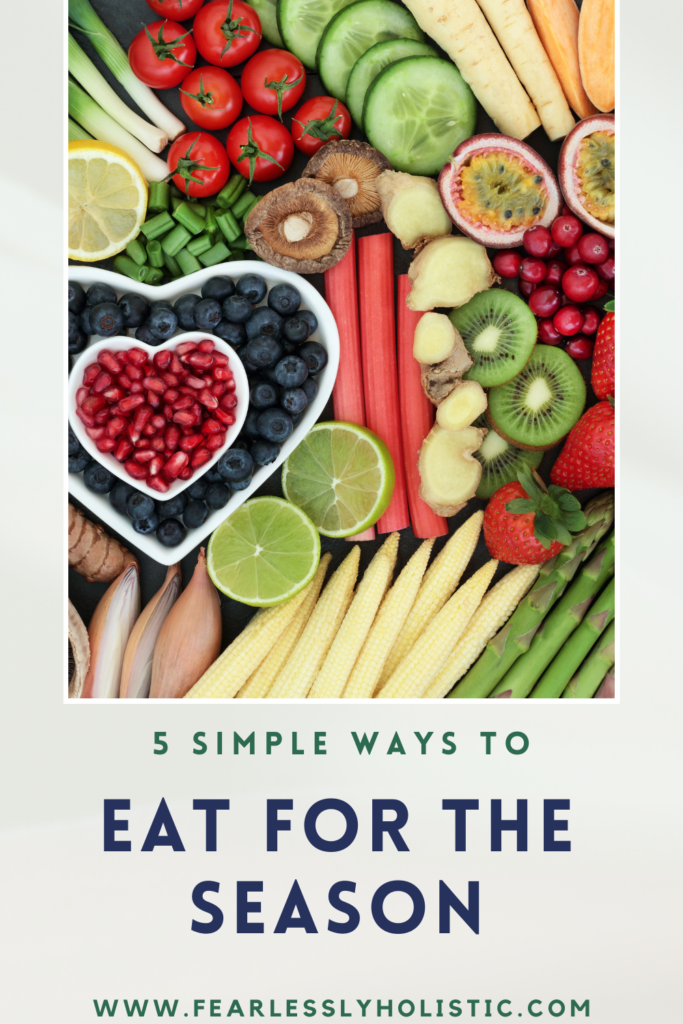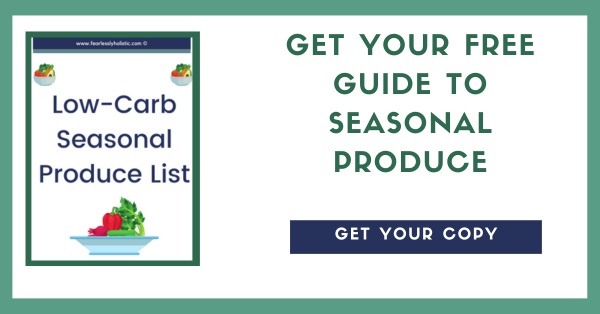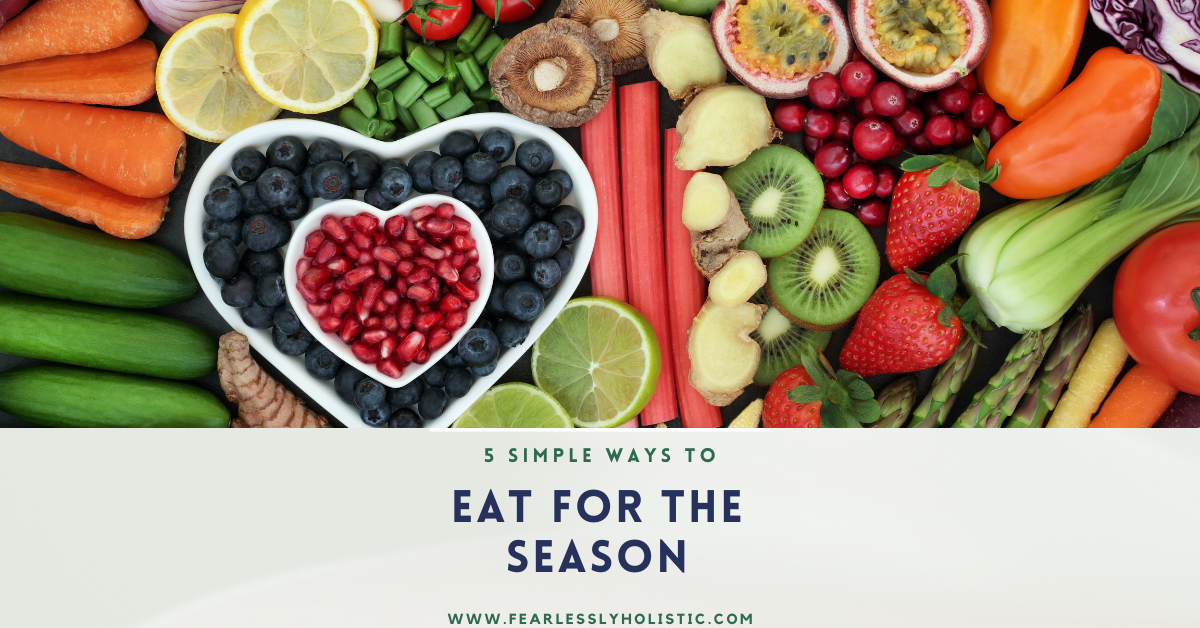What does it mean to eat for the season? Well, once upon a time that was our only option. These days though, you can buy food 24 hours a day, 7 days a week.
A quick trip to the produce section of a grocery store will show you a ton of choices, with produce from all over the world. You will probably see things you did not even know existed.
But there are a couple of reasons you may want to consider going back to eating more seasonal produce.
Hello and welcome to Fearlessly Holistic.
My name is Irma and I want to share my journey to improved health by eating whole foods, moving my body and eliminating stress as much as possible.
It is my hope to inspire you to make daily changes. Why? Because eating fresh, seasonal food, getting some sunshine, and purging unhelpful thinking is the best way to increase longevity. But you do not want just a long life.
You want a quality long life, and you want to look and feel your best while you live it.
Ready to eat for the season? Grab my SEASONAL PRODUCE GUIDE (low-carb too!) and start eating better today. Eating seasonally is better for your health, especially if you buy locally.
My blog posts are my opinion and the results of things that I have tried that either worked for me or didn’t. My opinions are for informational purposes only and are not intended as medical advice. Medical advice should always be obtained from a qualified medical professional for any health conditions or symptoms associated with them. As well, there may be affiliate links in this post. Read more here.
You may wonder how anything can beat the freedom to buy whatever produce you want 365 days a year, but I am going to show you how easy it is to start eating seasonally.
Eat in Season the Simple Way
There are several things that you can do to get started eating seasonally.
1. Check your grocery store for local produce and products
Of course this depends on what time of year it is, but you may find:
- Spring to early summer – this is a great time to buy local fresh leafy greens, as well as asparagus, cauliflower, cucumber and kale
- Summer – watch for local berries, beans, broccoli, cabbage, summer squash (zucchini), new potatoes, carrots…there are a lot of choices in summer
- Late summer to fall – apples, winter squash (like acorn or butternut), corn, potatoes, winter pears (like anjou), prune plums and plenty more
Buying locally is also a way of supporting your community and local/state farms. Be sure to watch for local honey, eggs, meats etc.

How to eat for the season
2. Go to your local Farmer’s Market
Where I live, we have a ‘mini’ market on Wednesday mornings as well as the full-blown big market on Saturdays. Both of these are good options, because farms have produce that is ripe every day.
Having a mid-week market lets farmers bring the freshest produce to market; otherwise it would sit around another few days and probably be wilted or limp.
The other benefit to the farmers market is that you get to know your local food producers.
If organic is your thing, you can find the folks who have that.
Our local Saturday market is almost like a fall fair: there are food stalls, craft stalls, people selling eggs and smoked meats, raw milk cheese (soooo good!). People bring their children in strollers and their dogs.
3. Watch for your local CSA program
CSA stands for community supported agriculture.
You can sometimes find links to these programs in Facebook marketplace. Be sure to check your local paper and community resource centers, which is where I found one.
For a monthly fee, you will get a box of fresh, local in-season produce.
The price of the box depends on how many people the box is for, so if you have a small family it will be cheaper.
I actually acquired a taste for spaghetti squash from getting a fall produce box. I ate absolutely everything that I got, and even got my brother into the program.
4. Consider making fermented foods from the excess
Fermented foods are how people used to preserve fruit and veggies before refridgeration was a thing. The microbes in fermented food are an excellent way to boost gut health, which helps you heal from illness faster.
Cultures all over the world have their own recipes for fermented foods.
Examples are:
- Kimchi from Korea
- Miso from Japan
- Kombucha from China
- Creme fraiche from France
- Sauerkraut from Europe
Fermented foods are usually put in a crock and left to start creating bacteria over a period of days or weeks.
For home fermenters, you can get started with a mason jar and salt. Here is my favorite recipe for sauerkraut.
I always hated the taste of commercial sauerkraut, but all that changed when I started making my own. You typically serve a small amount with meals, like you would a side of pickles.
My fresh batch was crisp, tangy and tasted like pickled cabbage which is how it is supposed to taste.
Another recipe that may interest you if you get a lot of colds and sickness in winter is fire cider. This is a mixture of fall veggies added to a large mason jar, with additions like apple cider vinegar and honey. You take a spoonful of this as a tonic to maintain gut health.
There are lots of videos for how to make fire cider and there are variations depending on where you live.
5. Seasonal produce delivers different nutrients to maintain health all year
For centuries, people would tend to get up when it was light and sleep when it was dark, to conserve energy and because not much was going on. Kind of like hibernation.
In spring, as the weather gets warmer and people are out getting their yards and gardens ready.
The first foods ready in the garden tend to be dark leafy greens, which are nutritional powerhouses. They boost health.
In summer, you get a large variety of produce and so also get a large variety of nutrients. These also help build up your immune system because you are outside doing more during the longer days.
Come fall, you get veggies that can be over-wintered, like potatoes, carrots, onions, garlic, parsnips etc. and fruit like apples and winter pears. The sweeter fruits help to fatten you up for a winter of less activity and more sleeping.
Conclusion
I have been combining seasonal eating with my keto diet, to have my own seasonal ketovore program, which I think this is the most holistic way to eat.
Watch for more articles on the ins and outs of seasonal eating and how to eat seasonally with keto diet.

Holism targets overall wellness, and when we are well, we only get better with age.
Eat the best food that you can afford to give your body the building blocks it needs for optimal health, longevity, and looking good for as long as possible 😉
Please share this post with anyone who can benefit from it. Sharing is caring! And follow me on Pinterest!
Until next time, here’s to our health!
-Irma
